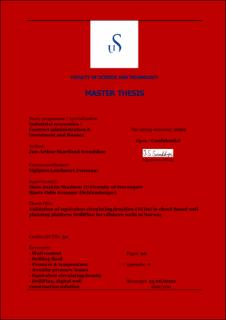| dc.description.abstract | This master thesis is written in collaboration with Schlumberger. Schlumberger wanted a
validation study of equivalent circulating density (ECD) modelling for offshore wells in
Norway. The accuracy of ECD modelling in their cloud-based digital well construction
solution, DrillPlan, was investigated.
ECD is a very essential aspect of well construction that needs to be understood in order to
maintain well control and avoid incidents while drilling. If the ECD is higher than expected, it
can lead to fracturing of formation, and consecutively drilling fluid losses to the formation.
The understanding and ability to predict ECD is important when it comes to assessing the
risks associated with drilling a well and determining whether the planned well design is
feasible or not.
To increase knowledge about ECD accuracy for Norwegian offshore conditions modelled in
DrillPlan, well- and drilling data were entered into DrillPlan so that the well planning
platform had the necessary information to run the desired ECD simulations. ECD simulations
were performed by DrillPlan’s hydraulic analysis, using drilling parameters from planning
and actual drilling parameters obtained from field operations. The simulated data set was
retrieved from DrillPlan, verified, and further analyzed in Microsoft Excel.
In this validation study, one 13.5-𝑖𝑛𝑐ℎ section, one 12.25-𝑖𝑛𝑐ℎ section, two 8.5-𝑖𝑛𝑐ℎ sections
and two 6-𝑖𝑛𝑐ℎ sections were examined. One of the 8.5-𝑖𝑛𝑐ℎ section had several
complexities, and it was considered as an outlier in the dataset, as it turned out that there were
additional uncertainties associated with the result. DrillPlan’s ability to accurately model the
ECD was varying for the sections mentioned above. When comparing simulated ECD-values
using actual parameters from DrillPlan with actual ECD-values measured from the field, the
deviation was smallest for the 13.5-𝑖𝑛𝑐ℎ- and 12.25-𝑖𝑛𝑐ℎ section, with an average section
deviation of 0.007 𝑆𝐺 and -0.006 𝑆𝐺, respectively. Simulated ECD-values for the 8.5-𝑖𝑛𝑐ℎ-
and 6-𝑖𝑛𝑐ℎ sections showed higher average section deviations of -0.013 𝑆𝐺 & -0.098 𝑆𝐺
(outlier), and -0.020 𝑆𝐺 & -0.037 𝑆𝐺 (temperature not calibrated), respectively. In other
words, DrillPlan is able to model ECD accurately in the shallower, larger hole sizes, but it is
showing a tendency to underestimate ECD in the deeper, slimmer hole sizes. | |
